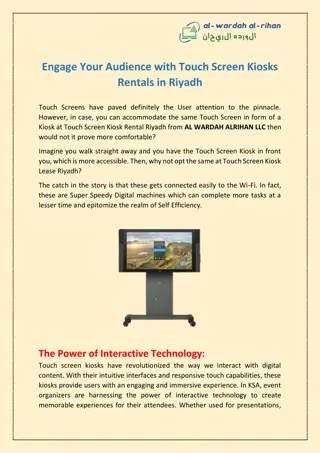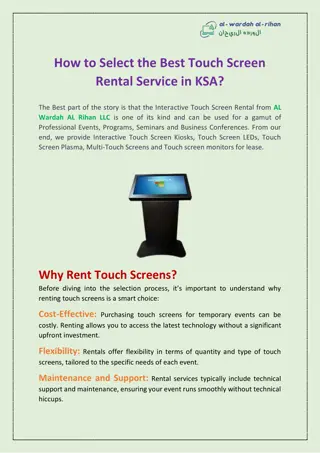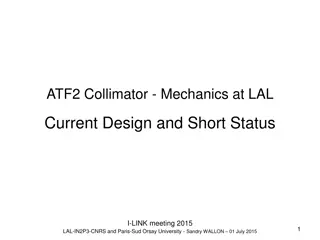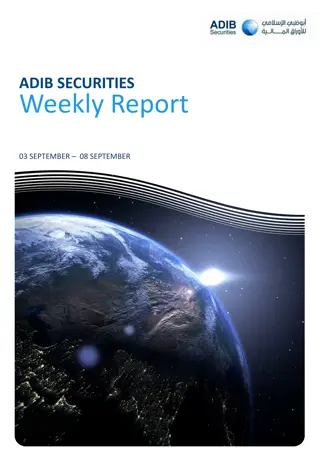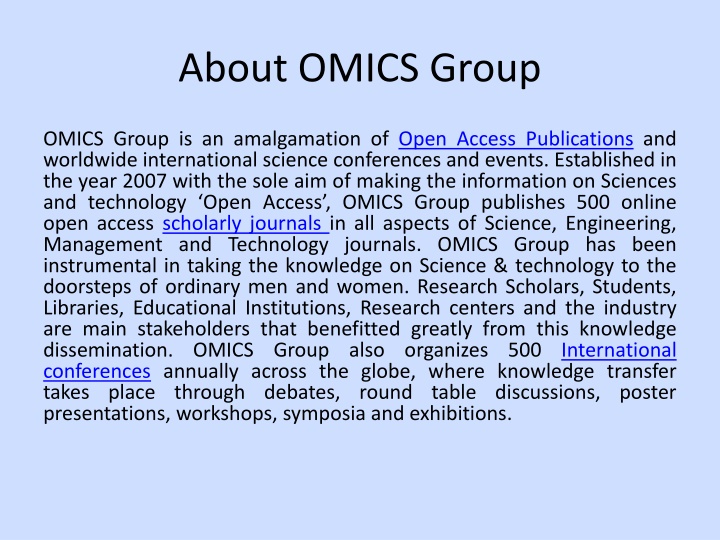
OMICS Group: Revolutionizing Knowledge Dissemination in Sciences & Technology
OMICS Group, established in 2007, is a global platform that offers open access publications and organizes over 500 international conferences annually. With 500 online scholarly journals covering various fields of Science, Engineering, Management, and Technology, OMICS Group aims to make information accessible to all stakeholders. Through debates, workshops, symposia, and exhibitions at their events, they facilitate knowledge transfer on a global scale.
Download Presentation

Please find below an Image/Link to download the presentation.
The content on the website is provided AS IS for your information and personal use only. It may not be sold, licensed, or shared on other websites without obtaining consent from the author. If you encounter any issues during the download, it is possible that the publisher has removed the file from their server.
You are allowed to download the files provided on this website for personal or commercial use, subject to the condition that they are used lawfully. All files are the property of their respective owners.
The content on the website is provided AS IS for your information and personal use only. It may not be sold, licensed, or shared on other websites without obtaining consent from the author.
E N D
Presentation Transcript
About OMICS Group OMICS Group is an amalgamation of Open Access Publications and worldwide international science conferences and events. Established in the year 2007 with the sole aim of making the information on Sciences and technology Open Access , OMICS Group publishes 500 online open access scholarly journals in all aspects of Science, Engineering, Management and Technology journals. OMICS Group has been instrumental in taking the knowledge on Science & technology to the doorsteps of ordinary men and women. Research Scholars, Students, Libraries, Educational Institutions, Research centers and the industry are main stakeholders that benefitted greatly from this knowledge dissemination. OMICS Group also organizes 500 International conferences annually across the globe, where knowledge transfer takes place through debates, round table discussions, poster presentations, workshops, symposia and exhibitions.
OMICS International Conferences OMICS International is a pioneer and leading science event organizer, which publishes around 500 open access journals and conducts over 500 Medical, Clinical, Engineering, Life Sciences, Pharma scientific conferences all over the globe annually with the support of more than 1000 scientific associations and 30,000 editorial board members and 3.5 million followers to its credit. OMICS Group has organized 500 conferences, workshops and national symposiums across the major cities including San Francisco, Las Vegas, San Antonio, Omaha, Orlando, Raleigh, Santa Clara, Chicago, Philadelphia, Kingdom, Valencia, Dubai, Beijing, Hyderabad, Bengaluru and Mumbai. Baltimore, United
WORLD CONGRESS ON PHARMACOLOGY 2015 July 20-22, Brisbane, Australia Workshop on Current And Future Trends in New Drug Current And Future Trends in New Drug Development in Type Development in Type- -2 Diabetes Mellitus By Dr Vivek Lal, Ph.D., M.D., F.Cl.R. Associate Professor (Pharmacology) College of Medicine, King Faisal University Kingdom of Saudi Arabia 2 Diabetes Mellitus
Sequence of discussion Introduction and Objectives Current drug therapy of T2DM Shortcomings of current modalities Recent advances Putative targets of future drug research Group activity Conclusion
Introduction T2DM : Some alarming facts 366 million patients globally May rise to 552 million by 2030 (International Diabetes Federation) Developing nations alarming increase in incidence Undiagnosed cases in Africa Adoption of unhealthy lifestyle - major problem
Objectives of Workshop Drug therapy of T2DM Where we are? Where are we headed? New drugs in the pipeline What are the fallacies / drawbacks of current trends? What should we target for optimal management of T2DM closest to a physiological control.
Current drug therapy of T2DM Stimulation of insulin secretion Insulin secretagogues (Sulfonylureas, meglitinides, D- phenylalanine derivatives) Facilitation of insulin action in liver, muscle and adipose tissue (Biguanides) Partial reduction of insulin resistance (Thiazolidinediones)
Current drug therapy of T2DM Delaying intestinal glucose absorption ( - glucosidase inhibitors) Enhancing action of incretins (GLP-1 agonists, DPP-4 inhibitors) Inhibition of glucose reabsorption in kidneys (SGLTs) Miscellaneous drugs (Pramlintide, Colesevelam)
Thus, where are we, currently? Flogging a dying horse! (Insulin secretagogues) ~ Insulin resistance a bigger problem than deficiency ~ Overstimulation of beta cells may be counter- productive ~ May lead to hypoglycemia Delaying intestinal glucose absorption ~ Unphysiological increases sugar content of feces with related adverse effects
Where are we? Enhancing incretin action (GLP-1 agonists & DPP Inhibitors) ~ GLP-1 stimulates insulin secretion (predominant action) ~ Di-peptidyl Peptidase (DPP) Inhibitors prevent breakdown of GLP-1 : similar action Promoting glycosuria! (SGLT2 Inhibitors) ~ Unphysiological! Prevent glucose reabsorption at renal PCT - glycosuria
Where are we? Colesevelam Indirect action through Farsenoid X receptor (FXR) FXR a nuclear receptor involved in cholesterol, glucose and bile acid metabolism activation inhibited by Colesevelam. May impair glucose absorption May aggravate hypertriglyceridemia + other ADRs Adjuvant drug at best!
Where are we? Bromocriptine A dopamine agonist Minimal HbA1c reduction by unknown mechanisms Many ADRs Mild to modest efficacy Use in T2DM questionable
Where are we? Currently, only the following groups appear rational:- Biguanides (euglycemic agents) ~ reduce hepatic glucose production ~ Promote peripheral glucose utilization Thiazolidinediones (PPAR- ligands) ~ PPAR- receptors modulate expression of genes involved in lipid / glucose metabolism, insulin signal transduction & adipocyte differentiation. ~ Facilitate insulin action in T2DM
Rational drugs in T2DM (Contd) Pramlintide [Islet Amyloid Polypeptide (IAPP) analog] ~ Prevents insulin over-secretion [(-)ve feedback] ~ Reduces glucagon secretion ~ Delays gastric emptying (attenuates post- prandial surge in blood glucose levels) ~ Decreases appetite centrally
Where are we headed? Failed attempts! - Rimonabant depression! - Dual PPAR- + agonists (Glitazars Muraglitazar & Tesaglitazar) dual action of enhancing insulin action & plasma TGs + HDL. High adverse effects like heart failure. - Fasiglifam development terminated (2013) due to safety concerns (Liver toxicity)
Where are we headed? 11beta-hydroxysteroid dehydrogenase type 1 (11- HSD-1) inhibitors Inhibit the oxidoreductase catalyzing conversion of 11 ketoforms (cortisone) into active gluco- corticoids. This prevents excessive glucocorticoid action which accentuates T2DM. Again, an indirect approach!
Glycogen Phosphorylase Inhibitors Inhibit conversion of glycogen into glucose Expected lowering on blood glucose in T2DM Selectivity of action on liver doubtful breakdown of glycogen in skeletal muscles is essential Clinical evaluation mandated Glucokinase Activators Increase insulin secretion similar limitations as other insulinsecretagogues! Promote glucose uptake and reduce release of glucose from liver. Multiple clinical concerns(+)
Protein tyrosine phosphatase 1B inhibitors PTP 1B is a cytosolic protein tyrosine phosphatase Implicated as a negative regulator of insulin signal transduction PTP 1B inhibitors can thus overcome insulin resistance Several classes of such inhibitors are under investigation
GPR-119 agonists G-Protein coupled Receptor-119 expressed in pancreas & GIT Activated by lipid amides Leads to release of Insulin, GLP-1 and GIP Likely to have similar problems as insulin secretagogues
Glucagon Receptor Antagonists Under development Block action of glucagon block glucagon mediated glycogenolysis and subsequent hyperglycemia Useful only in patients with overexpression of glucagon receptors May accentuate hypoglycemia Adjuvant drugs at best!
What we can do..finally! Objectives for rational pharmacotherapy of T2DM Islet beta cells should not be strained further Insulin resistance to be overcome at all levels ~ By direct action on insulin receptors ~ Insulin facilitators Increased sugar levels in feces & urine to be avoided Effective reversal of Insulin antagonism
Insulin Signal Transduction (Brief) Insulin binding to cell surface receptor Tyrosine phosphorylation of Insulin Receptor Substrates (IRSs) Activation of PI3K by binding of IRSs on its regulatory subunit Activation of 3-phosphoinositide dependent protein kinases (PDK-1 & PDK-2) Activation of Akt/Protein kinase B (PKB) / atypical protein kinase C / Activation of 160 kDa substrate (AS 160)
Insulin Signal Transduction (Brief) Activation of AS 160 Translocation of Insulin mediated GLUT-4 from I/cellular vesicles to plasma membrane Extra to intracellular transport of glucose ----------------------------------------------------------------------- Rho-Kinase (ROCK1 & ROCK2) Facilitates insulin stimulated IRS-1 associated PI3K activity (by 632/635 serine phosphorylation of IRS-1) Negative ROCK activity promotes insulin resistance
Negative modulators for insulin signalling Physiological regulation of insulin action = Balance between phosphorylation and dephosphorylation of IR by Protein tyrosine phosphatases Additionally, a lipid phosphatase (PTEN) hydrolyzes conversion of PIP3 to PIP2 antagonizes the PI3K pathway of insulin signal transduction can contribute to insulin resistance
Insulin Receptor : Normal Signal Transduction (PIP3) (PIP3) (PIP2 Normal Signal Transduction
Target 1: Inhibition of serine phosphorylation of IRS-1 (PIP3) (PIP3) (PIP2) Serine Phosphorylation Reduced attraction of IRS to PI3K Thus, inhibition of serine phosphorylation of IRS-1 can reduce insulin resistance
Target 2 : Correction of mitochondrial dysfunction Mitochondrial dysfunction in insulin target tissues activation of several serine kinase Serine phosphorylation of IRS-1 Insulin Resistance Thus, drug induced manipulation to prevent mitochondrial dysfunction can prevent insulin resistance
Target 3: Inhibition of over-expression of p85alpha subunit of PI3K Overexpression of p85alpha subunit of Phosphatidylinositol (PI) 3 kinase seen in overfeeding related insulin resistance Inhibition of overexpression of p85alpha subunit or immunological inhibition of this protein expected to reduce insulin resistance
Target 4: Stimulation of a novel insulin receptor signalling platform Membrane associated mammalian neuraminidase-1 (Neu1) + matrix metallo- proteinase-9 (MMP-9) + Neuromedin B G-protein coupled receptor (GPCR) Essential for insulin induced IR stimulation Many ligands (Oseltamivir / Piperazine / BIM- 23127 respectively) can block these enzymes / receptor proteins insulin resistance
Target 4: Stimulation of a novel insulin receptor signalling platform Thus, individual or combined stimulation of these cross talk mechanisms can overcome or decrease insulin resistance Novel ligands can be searched by receptor ligand matching techniques, which can stimulate individual entities
Target 5 : Inhibition of PTEN PTEN is a negative modulator of insulin signal transduction Its inhibition might be attempted by blocking this lipid phosphatase by novel blockers Alternatively, its expression may be inhibited on chromosome 10 This can also contribute to overcoming insulin resistance
Group Activity All participants are now requested to jot down their own ideas about future research in T2DM management, especially with an overview of the shortcomings of the currently available drugs.
Conclusion Currently available pharmacological management of T2DM has many shortfalls! Hypoglycemia, weight gain, altered lipid profile and most importantly a poor glycemic control are major problems. Of late, research got directed towards reducing blood sugar by irrational means iatrogenic glycosuria and loss of sugars in stools inherently dangerous!
Conclusion Out of the on-going research, only glycogen phosphorylase inhibitors and Protein Tyrosine Phosphatase 1B (PTP 1B) inhibitors show some promise This workshop intended to suggest future research targets which may reduce insulin resistance Mainstay of T2DM treatment is reduction of insulin resistance, and not insulin secretion! This can precede future gene therapy!
Let us meet again.. We welcome you all to our future conferences of OMICS International 3rd World Congress on Pharmacology On August 08-10, 2016 at Birmingham, UK http://pharmacology.pharmaceuticalconferences.com/


